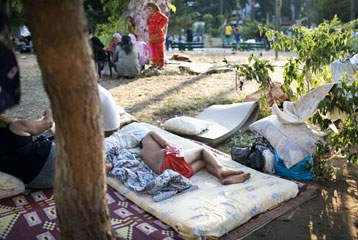Geneva is the headquarters of the International Red Cross. It is also the custodian of the conventions which protect civilians, the injured and soldiers in times of war.
It is difficult to dissociate the history of the Geneva Conventions from that of the Red Cross, as the latter was at the origin of the first Convention of 1864.
Henri Dunant, shocked by the horrors of the battle of Solferino, worked on a project which was later to become the International Committee on the Red Cross. The lawyer Gustave Moynier, General Dufour and the doctors Appia and Maunoir helped him organise an international conference with the aim of overcoming the lack of protection afforded the war-wounded.
The first Geneva Convention: how to protect the war-wounded?
An invitation was sent to the European states. On 26 October 1863, the conference counted 36 participants while 14 governments were represented. At the end of the conference, 10 resolutions formed the basis for the aid societies for wounded soldiers, the future societies of the Red Cross and the Red Crescent.
The International Committee prepared the next step: a diplomatic conference. On 6 June 1864, the Swiss government invited all the European governments as well as those from Brazil, Mexico and the US to attend. Thus, from 8 to 22 August, delegates from 16 states debated the draft convention prepared by the committee. On 22 August 1864, the first Convention was signed to improve the fate of soldiers wounded on the field of battle.
Birth of international humanitarian law
Geneva is not only the place after which these Conventions were named. The state of Geneva is also the custodian of the Conventions.
These texts mark the birth of international humanitarian law, the application of which is primarily guaranteed by the International Committee on the Red Cross. Nevertheless, their implementation is the responsibility of the member states who undertake to comply with and ensure compliance with these provisions in all circumstances. In the event of a serious infringement, for example torture, the International Criminal Court judge war crimes as defined by the Conventions.
Following the first Geneva Convention, the text adopted in 1929 concerning the protection of prisoners of war was added. Shortly after World War Two, the first two texts were adapted to the issues of the time.
The Conventions of 1949
The first two Conventions concerned an improvement in the conditions of people who were sick, injured or soldiers. They also deal with medical personnel taken prison by the enemy.
The third Convention governs the treatment of prisoners of war. Soldiers can be prevented from taking up arms, but they must be respected. Prisoners must be treated humanely; legally protected, they cannot be subjected to any form or physical or psychological torture, their religion must be respected and they must receive all the care necessary to their survival.
The fourth Convention covers the safety of civilians in times of war: they cannot be taken hostage or deported. Collective punishments are prohibited and the army, even an enemy force, must ensure their protection. No reprisals against them are permitted.
Article modifié le 02.03.2020 à 14:27


